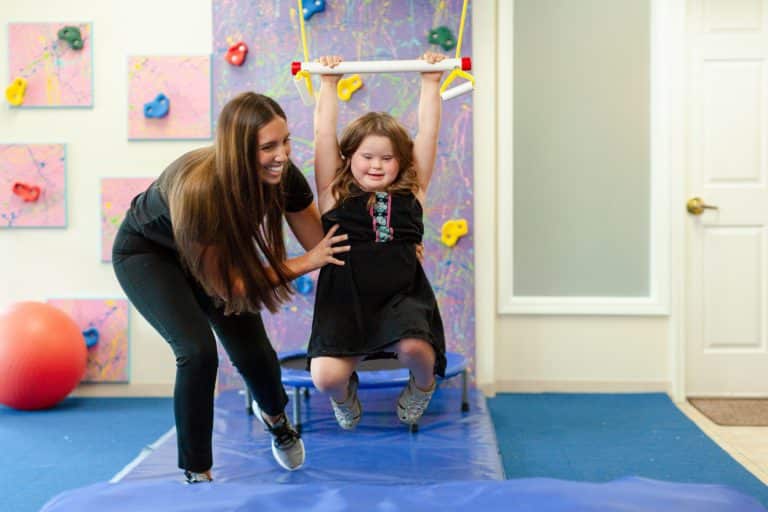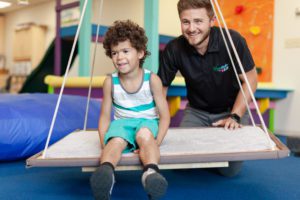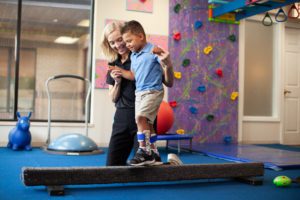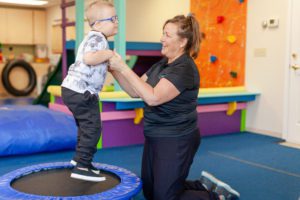
Welcome to a Pediatric Physical Therapy Clinic | Equipment & Activity Guide
A pediatric physical therapy clinic looks a little bit different from the adult setting. This is a guide to some of the popular pieces of equipment that you will see pediatric physical therapists use with kids of various age groups and diagnoses in a clinic. Some of these pieces are also available to purchase in retail settings and are great pieces to add to your home. Some of these tools make great gift-giving ideas too!
Swings
Swings are one thing you generally will not find in an adult physical therapy setting but are a great asset to our pediatric physical therapists. Swings are a great way to provide sensory input. They also offer a great range of benefits for core strengthening, anticipatory and reactive balance, postural endurance, motor planning, and coordination.
Moon Swing – This swing consists of a bulbous bottom for children to sit on. They are used to promote core strengthening, bilateral coordination, and balance.
Activity ideas:
- Holding onto the moon swing while reaching for items on the floor or dropping items into a bucket
- Maintain balance in response to a motion
Platform Swing – A platform swing has a large square base and is hung by four ropes. This swing type provides an unstable surface for various positions to work on core strengthening and balance.
Activity ideas:
- Prone positioning while reaching for items on the floor or completing a puzzle
- Tailor sitting activities
- Quadruped
- Tall kneeling

Bolster Swing – A bolster swing has a long circular base. It works on core strengthening from a straddle seated position – a good balance challenge!
Activity ideas:
- Pump swing forward and backward
- Add trunk rotation by placing the bolster swing between two support surfaces and transferring objects from one surface to the other
- Try prone, aka belly, positioning on bolster swing near floor while putting together a puzzle for added upper body and gluteal strengthening
Rainbow Acrobat Swing – A rainbow acrobat swing is a large square hammock-like swing hung from 2, 3, or 4 attachment sites in the ceiling. It comprises four layers of stretchy fabric (blue, green, yellow, and red). This swing is excellent for motor planning, body awareness, balance, and core strengthening.
Activity ideas:
- Hide small toys between layers and have the child climb through the layers to find them.
- Clip clothespins at the four corners of the swing and have the child climb up the sides of the swing to retrieve them
Sling/Hammock Swing – A sling or hammock swing looks like a hammock you may find in a backyard. It’s made of flexible yet durable fabric. This swing promotes core, gluteal and upper body strengthening in a prone position or swing in a seated position.
Activity ideas:
- Superman pose
- Putting together a puzzle on the floor
Trapeze Swing – A trapeze swing has a single bar with two ropes on both sides. It’s a big hit with kiddos who are into gymnastics. This swing works on the hip, abdominal, upper body, and grip strength.
Activity ideas:
- Hold knees to chest for as long as you can and then drop into the crash pad
- Swing from one platform to another
- Try to lift feet and kick over bolster while hanging on
- Try lifting feet to clear barrel when swinging from one surface to another
Climbing Rope Swing – There are a few variations of climbing rope swings. You could see a rope ladder swing or a rope with knots with a round base. Rope swings are used to develop coordination and improve balance and muscle development.
Activity ideas:
- Climb to reach and grab items off a taller surface
Steering Wheel Swing – A steering wheel swing has a single rope with a plastic steering wheel at the end of the rope. This swing is suitable for upper body and abdominal or hamstring strengthening
Activity ideas:
- See how many times you can spin in a circle before touching your feet down to the floor
- Hold on and lift your feet to kick over a bolster
Cuddle/Cocoon Swing – A cuddle or cocoon swing looks like a pod or a caterpillar cocoon and is made of flexible fabric. It’s primarily used for occupational therapy and help regulate or calm children who are overstimulated during therapy.
Activity ideas:
- Practice climbing in and out of the cocoon
- Spin around
- Cuddle up in the cocoon with a book, music, or game to relax
Obstacle Course Equipment
Obstacle course equipment is another fun pediatric-specific type of equipment you may see used in a pediatric physical therapy office. This type of equipment targets various therapeutic activities by creating a fun obstacle course throughout the gym.
Balance Beam – Using balance beams improves balance, body awareness, coordination, and reaction.
Activity ideas:
- Heel-to-toe walking
- Backward walking
- Sidestepping
- Increase balance challenge by stepping over obstacles along the balance beam or picking up objects on the floor along the balance beam without feet touching floor

Rainbow Road – Balance beam with a twist! A rainbow road is made of separate pieces with curves. These pieces can be rearranged to make various size curves or break it down into pieces for a variety of other activities as well.
Activity ideas:
- See balance beam activities above
- Step onto or over the pieces
- Practice stepping onto pieces and jumping down
- Jump over the pieces
Stepping Stones – Stepping stones are large, bright-colored pieces that mimic natural stepping stones you would find in a garden or stream. They are a great way to practice anticipatory balance, balancing in a narrowed base of support and balance on uneven surfaces.
Activity ideas:
- Place in a straight line or staggered line to negotiate
- Place in a staggered pattern and give cues for which color to step to, encouraging steps in various directions
Incline Ramp – An incline ramp is a dense form shaped like a large wedge or ramp. They are used to practice incline and decline negotiation or climbing and jumping. Good for hip/lower extremity and core strengthening, balance/coordination, and motor planning.
Activity ideas:
- Climb up the ramp and jump down
- Walk up and down forward, sideways, backward
- Crawling or bear crawls up and down
- Make tummy time a little easier for babies by practicing on the incline
Colored Dots/Floor Markers – Colored dots are large stickers to mark a spot on the floor. These provide visual cues on the floor for a variety of activities.
Activity ideas:
- Lilly pad jumps – jumping from one dot to another
- Use as colored cues for animal walks, inch worms, etc.
Feet Markers – Feet markers are also large shapes of feet. These are a fun way to use as a visual cue for foot placement during various activities.
Activity ideas:
- Place them on steps to facilitate a reciprocal pattern to ascend or descend
- Place on the floor to queue for appropriate foot alignment with lateral stepping
- Place on the floor to queue for bilateral foot push-off and landing during jumping
Foam Octagon – A foam octagon is a large foam barrel that can be used as an unstable surface to negotiate or as a large object to push or pull.
Activity ideas:
- Push barrel through a crash pad
- Place at the end of the ramp or between two foam ramps, stepping onto or climbing an unstable surface at the top of the ramp
Foam Tunnel – A foam tunnel is a circular piece of dense foam that a child can fit in. It’s an unstable tunnel with a removable bolster in the middle to facilitate core strengthening
Activity ideas:
- Crawl through the tunnel while trying to maintain a quadruped position
- Rolling inside of the tunnel
- Place upright and try to climb into and out of the tunnel
Fabric Tunnel – A fabric tunnel is a common tunnel used for play, and it’s much more flexible than a foam tunnel with a bolster. It’s also much longer than a foam tunnel. This type of tunnel encourages four-point crawling and core strengthening.
Activity ideas:
- Facilitate transitions by changing directions while crawling through the tunnel
- Crawl through a tunnel placed over compliant/uneven surface (crash pad)
- Crawl through a tunnel placed on an incline
Crash Pad – A crash pad is a kid’s favorite! It’s an extra-large dense, fluffy cushion. It creates a fun surface to jump into but can also be used for core strengthening and balance.
Activity ideas:
- Drop into crash pad from swing, trapeze
- Jump into a crash pad from an elevated surface
- Practice balance by standing on or walking over a crash pad
- Facilitate four-point crawling and transitions by having your baby negotiate the pad on their tummy
Scooter – A gym class classic! Scooters can be used in a belly or seated position to target upper body, core, hip, and lower extremity strengthening, motor planning, coordination, and body awareness.
Activity ideas:
- Find objects hidden by progressing forward in sitting to target lower extremities and abdominals, and then try in prone to target upper body and gluteal strength
- Progress forward using heels with toes off the floor for kids with limited active dorsiflexion range/toe walking
- Criss-cross sitting on a scooter while using rope or plunger to progress forward for trunk strengthening
Wooden Steps – Wooden steps are usually four steps to simulate a large staircase in a home or community. These can be used as a small staircase or as individual steps to step on or sit on.
Activity ideas:
- Practice stair negotiation independently or near a wall for support
- Practice step ups and downs or jumping from step to the floor, increasing height as tolerated
- Use as a bench to perform sit to stands
Other Frequently Used Equipment
Pediatric physical therapy facilities use a variety of toys, including play food, puzzles, building toys, board games, baby toys, and many more, to encourage kids to participate in various play-based therapeutic activities.
While some of these items below are like items you would see in an adult clinic, pediatric clinics incorporate them into play-based treatment strategies to address various therapeutic goals in children.
Step Stool – This simple piece of equipment is one of the most frequently used for kids of all age groups in both clinics and Early Intervention!
Activity ideas:
- Practice modified quadruped in preparation for four-point crawling with your hands on a step stool and knees on the floor
- Practice sitting on stool for core strengthening in newly independent sitters
- Practice sitting to standing in preparation for standing/walking
- Practice steps ups/downs or jumping down for toddlers
Therapy Ball – Therapy balls are standard in adult physical therapy clinics; however, in a pediatric facility, they are much smaller to accommodate children. These are used for sitting, core, or balance exercises, or they are fun just to roll around!
Activity ideas:
- Use for seated core strengthening and balance/postural stability or tummy time
- Use to treat lateral head tilt in babies with torticollis and facilitate trunk elongation by tilting to the left or right to elicit righting reactions
Peanut Ball – A peanut ball gets its name from its unique shape, like a roasted peanut in its shell! These are large, like exercise balls but with a longer, more curved shape.
Activity ideas:
- Straddle sitting play
- Prone walkouts and prone play with hip extension
Donut Ball – A donut ball also gets its name from the food it looks like! This type of ball is a flattened circle with a hole in the middle. This is a stability ball to target postural stability and core strengthening.
Activity ideas:
- Tailor sitting play
- Tall kneeling play
Bolsters – Bolsters come in all shapes and sizes, making them very versatile. They can be used alone for support or combined with doing exercises.
Activity ideas:
- Straddle sitting play
- Prone positioning with hip extension while playing with a toy on the floor
- Prone walkouts
- Hang from ceiling and use for kicking (single leg stance, from trapeze swing)
Pediatric Bosu – Bosu, meaning both sides up, is another common tool in adult physical therapy clinics. A pediatric Bosu is, of course, kids’ size! It can be used with the round side or flat side up to target sitting or standing balance reactions, facilitate alignment and participate in core and lower extremity strengthening.
Activity ideas:
- Tailor sitting flat side up, reaching in various directions for toys or to pop bubbles
- Tall kneeling on round side
- Standing/squatting on round or flat side (fishing, putting objects on cones, etc.)
- Upper extremity weight bearing for shoulder strength/stability
Monkey Balance Board – A monkey balance board is a standard balance board but created as an adorable monkey. These are used to work on foot/ankle strengthening, lower extremity strengthening, balance, and alignment.
Activity ideas:
- Balance in medial-lateral position or anterior-posterior position
- Perform squats while maintaining monkey balanced in the center
Rocking Boat/Stairs – A rocking boat and stairs is a versatile piece of equipment that, when flipped one way, looks like a boat, and when flipped the other way offers three steps to ascend and descend.
Activity ideas:
- Practice ascending and descending steps in a reciprocal pattern
- Sit in the boat and catch fish on the floor with a magnetic fishing pole to target core strengthening and trunk rotation while using imagination
Trampoline – A trampoline in a physical therapy clinic is a miniature version of an outdoor trampoline. Trampolines are a big hit with children and improve gross motor skills, balance, and coordination.
Activity ideas:
- Practice jumping with or without upper extremity support
- Use an unstable surface to stand/squat on for balance training

We’re here for you
At Ivy Rehab for Kids, we’re all about the kids, and we’re dedicated to making therapy fun! Our highly trained pediatric physical therapists work one-on-one with patients, encourage progress and form lasting bonds.
If your child is experiencing gross motor delay, a birth-related injury, balance deficit, has a neuromuscular condition, torticollis, or any other conditions that could benefit from physical therapy, contact a location today. Visit our website to request an appointment online or find a location near you.
The medical information contained herein is provided as an information resource only, and does not substitute professional medical advice or consultation with healthcare professionals. This information is not intended to be patient education, does not create any patient-provider relationship, and should not be used as a substitute for professional diagnosis, treatment or medical advice. Please consult with your healthcare provider before making any healthcare decisions or for guidance about a specific medical condition. If you think you have a medical emergency, call your doctor or 911 immediately. IvyRehab Network, Inc. disclaims any and all responsibility, and shall have no liability, for any damages, loss, injury or liability whatsoever suffered as a result of your reliance on the information contained herein.